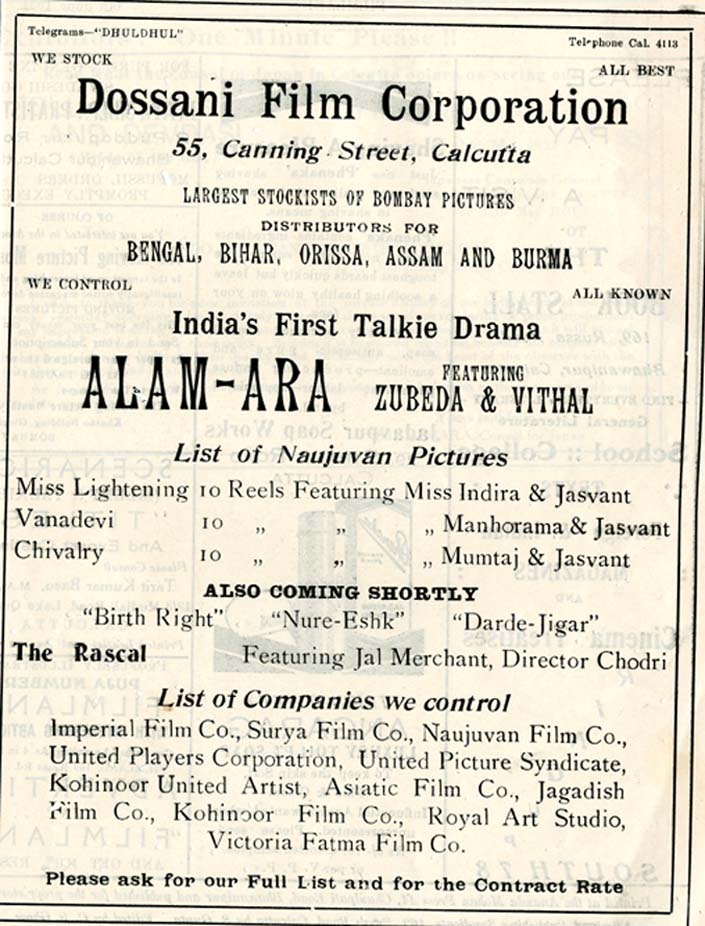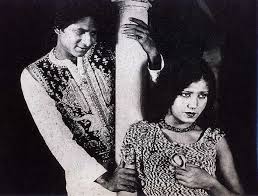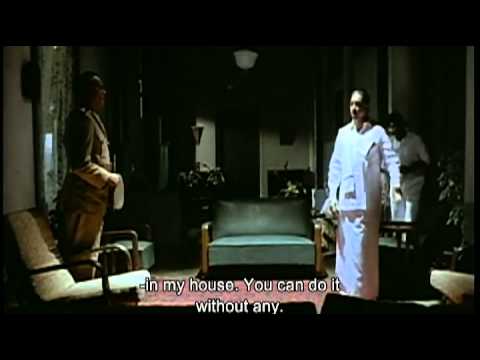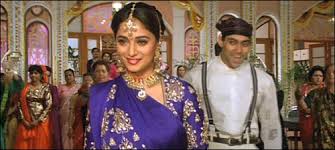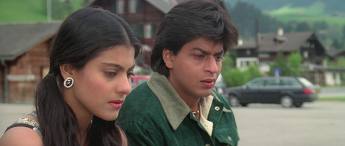Cinema in India before 1913
(→1960) |
(→1970) |
||
| Line 33: | Line 33: | ||
1912 : Two amateurs N.G. Chitre and R.G. Torney attempt a narrative film, about 1500 feet long, of a play - Pundalik. | 1912 : Two amateurs N.G. Chitre and R.G. Torney attempt a narrative film, about 1500 feet long, of a play - Pundalik. | ||
| − | |||
| − | |||
| − | |||
| − | |||
| − | |||
| − | |||
| − | |||
| − | |||
| − | |||
| − | |||
| − | |||
| − | |||
| − | |||
| − | |||
| − | |||
| − | |||
| − | |||
| − | |||
| − | |||
| − | |||
| − | |||
===1980=== | ===1980=== | ||
Revision as of 10:01, 23 March 2013
Contents |
Indian (mainly Hindi-Urdu) cinema
Title and authorship of the original article(s)
|
Brief history of Indian cinema By UrooJ, aligarians.com, Mid-2000 |
This is an article selected for the excellence of its content. |
1907
1907 : J.F. Madan opens the Elphinstone Picture Palace in Calcutta, the first of his cinema chain. Pathe establishes office in India.
1908 : Abdulallay Esoofally, a South Asian and Singaporean traveling showman starts exhibiting in India.
1910
1910 : Dadasaheb Phalke attends a screening of The Life of Christ at P.B. Mehta’s American - Indian Cinema and decides to become a filmmaker himself.
1911 : Anandi Bose, Debi Bose and others start the Aurora Cinema Co. showing films in tents as part of a variety bill. The Coronation Durbar of King George V held in Delhi is filmed by several Indians. (S.N. Patankar, Hiralal Sen, Madan Theatres)
1912 : Two amateurs N.G. Chitre and R.G. Torney attempt a narrative film, about 1500 feet long, of a play - Pundalik.
1980
1980 : FFC and Indian Motion Picture Export Corporation merge to form the National Film Development Corporation (NFDC). The Lotus Cinema hired by the FFC becomes Bombay’s only venue for art-house films beginning with Bimal Dutt’s Kasturi (1978). K.S. Karanth’s Report of the Working Group on National Film Policy is published and ignored by the Government. Independent Filmmakers start the Forum for Better Cinema and ask the Government to ask Satyajit Ray to head the organization. Ray turns down the offer. While on Ray, a retrospective of his films is held at the Indian International Film Festival. Mrinal Sen retrospective is held at the National film Theatre, London. The journal Cinema Vision India starts in Bombay with an issue on Silent Cinema in India. Deaths of Mohd. Rafi, Uttam Kumar, Sahir Ludhianvi.
1981 : Indian Film Industry celebrates the golden jubilee of the Indian Talkie. Formation of the short-lived Indian Academy of Motion Pictures Arts and Science (IAMPAS). A three part package of Indian Cinema - pre-Ray, a Ray retrospective and New Indian Cinema tours the United States. Special issue on Indian Cinema by the Journal for Asian literature. Death of Nargis.
1982 : Adoor Gopalakrishnan’s Elipattahyam wins prestigious British Film Institute Award. Shekar Kapur’s debut Masoom. Asian games held in Delhi provide the occasion to start telecasting of colour programmes on TV. N.T. Rama Rao starts the Telegu Desam Party. The Tamil Film weekly Gemini Cinema starts. First films in Brijbhasha (Brij Bhoomi) and Malvi (Bhadwa Mata).
1983 : Mrinal Sen’s Kharij wins special Special Jury Prize at Cannes. Bhanu Athaiya becomes the first Indian to win an Oscar for costumes designed for Richard Attenborough’s Gandhi (1982). Panorama of Indian Cinema at the Centre Pompidou, Paris. First film in Garhwali (Jagwal) and Khasi (Ka Lawei Ha Ki Ktijong Ngi). The Karnataka state subsidy to films is increased to Rs one lakh for B&W and Rs 1.5 lakh for colour.
1985 : Indian Cinema Season at Pesaro Film Festival, Italy.
1986 : Death of Smita Patil.
1987 : The NFDC starts the quarterly journal Cinema in India. Death of Kishore Kumar.
1988 : The journals Cinemaya (A quarterly on Asian film) and Deep Focus start. Death of Raj Kapoor.
1989 : Death of Prem Nazir.
1990
1990 : The first Bombay International Film Festival for Documentaries and Short Films held. Satyajit Ray presented the Legion d’honneur by French President Francois Mitterand in Calcutta. Death of V. Shantaram.
1991 : Deaths of Nutan, Durga Khote.
1992 : Satyajit Ray awarded the Oscar for Lifetime Achievement and the Bharat Ratna, India’s highest civilian honour. Death of Ray. Five selected regional TV channels go national.
1993 : Bill to regulate Cable TV introduced in Lok Sabha. Five more Doordarshan channels are launched. Murdoch’s Star TV acquires 49.9 % shares in the Zee TV network. Controversy over the Choli ke Peeche Kya Hai song in Khalnayak.
1994 : Hum Aapke Hain Kaun is declared the biggest hit in the history of Indian cinema. The Sarkailo Khatiya song in Raja Babu causes a scandal leading to the announcement of amendments in the Censor Code. Shekhar Kapur’s Bandit Queen runs into censor problems. Jurassic Park (1992) is dubbed into Hindi and is a big success paving the way for dubbed versions of other Hollywood films.
1995 : Aditya Chopra makes his debut with the mega hit Dilwaale Dulhania Le Jayenge. Mani Ratnam’s Bombay releases after it is cleared by Shiv Sena chief Bal Thakeray. CNN announces a news channel with Doordarshan.
1996 : First V. Shantaram Award for Lifetime Achievement in the field of Documentary Film presented to B.D. Garga. N.T. Rama Rao dies.
1997 : Gulshan Kumar, owner of T-series and pioneer of the audiocassette revolution of the 1990s, is assassinated. Leading music director Nadeem accused of the murder. Accusations abound about the criminalization of the Film Industry.
1998 : The Government declares the Film Industry as a legitimate Industry qualifying it for Institutional Finance. Shekhar Kapur makes a major breakthrough in the West with Elizabeth. Both Dil Se and Kuch Kuch Hota Hai enter the UK top 10. A small independent film Hyderabad Blues is the sleeper hit of the year paving the way for the production of a series of low budget ‘different’ films.
1999 : Elizabeth goes on to win several Oscar nominations including one for Best film. Shekar Kapur however misses the Best Director nomination. Manoj Night Shyamalan of Indian origin breaks through Hollywood in a major way following the success of The Sixth Sense. The first fully insured Indian film Taal enters the US top 20. Santosh Sivam’s Terrorist has a successful run at the box office besides being screened at various film festivals around the world. Amitabh Bachchan declared the superstar of the millennium ahead of such greats as Charlie Chaplin and Sir Laurence Olivier.
2000
2000 : Terrorist has a release in the USA. The Sixth Sense receives Oscar nominations in the Best Film, Director and Original Screenplay among other categories but wins none. Kaho na Pyaar Hai introduces the brightest new discovery in Indian Cinema in a long time - Hritik Roshan. IIFA, the Indian International Film Awards launched.


